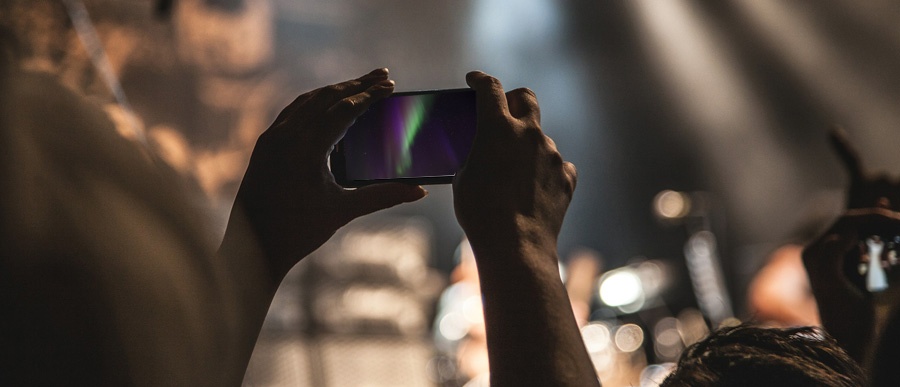When it comes to incorporating technology for events, planners walk a fine line. Failing to use any technology can make your event feel antiquated and boring. But too much technology can complicate things, make attendees feel overwhelmed, and reduce your interaction rate altogether. Here are 10 strategies for keeping your technology for events in check.
When to Incorporate Technology at Events

1. Technology can assist with easy pricing and sign up options. You need a strong event website that is well designed and an event registration page that people can find easily. No one will attend your event if they can’t register for it! There are many online event management platforms that can help with registration, among other management tools. Bizaboo, Eventbrite and EventZilla are popular registration programs.
2. Use technology for event promotion. Consider which social media channels your attendees use most often. Then, use those channels to promote your event through maintaining activity on popular channels to create buzz. If social media advertising isn’t getting you the results you want, you can try paid Facebook Ads or Google Adwords. Set a budget and find your target audience.
3. Another way of using technology to promote events is video. The internet is growing increasingly more visual and video is a great way to communicate the excitement and energy of a live event. Get backstage footage of your event speaker preparing for a presentation. Then post to all of your website and other social media channels.
4. Technology helps with attendee interaction. Walking into a large trade show may make the age-old task of networking a little bit overwhelming. Luckily, technology has responded to the wary networker by with a number of location-based services. A helpful networking app is Grip (formerly known as Networkr). A Tinder swipe style interface connects with LinkedIn information so attendees can focus their time on high-value interactions who are in proximity.
5. Technology clarifies tasks for internal staff. Do you have one team working on food, another on agenda, one on sponsors and yet another on activities outside of the event? Have them all work with one event program so that complicated ideas can be concentrated in one simple output. An event planner tool like Event Ready can help with every task from the front end to the back end. Vetting speakers, handling vendors, to food and beverage and designing floorplans; this software can get your whole team on the same page very quickly.
6. Use technology for fun. At last year’s Cannes Film Festival, the Urban Airship tech firm partnered with the Intergalactic digital agency to create the app RoséTime. When attendees entered the VIP area they were sent a notification, “Rosétime?” If they clicked yes, a chilled glass of wine was delivered to their location. Beacon technology was used to connect with attendees who had already downloaded the app.
7. Share your message with technology. Is a breakout session filled up? Did you change rooms for happy hour? Alert all attendees immediately with a mass message sent through your event app.

8. Track attendees better with technology. Beacon technology can effectively track attendees as they experience your event. Find out which booth or session they spent the most time in and add it to their profile. They can use this when connecting with other attendees.
9. Use technology to capture information. Drones are popular at large events to capture aerial shots. These images can then be provided to attendees, sponsors or for use in your highlight reel.
10. Technology can provide valuable real-time feedback. The mobile app use of polls; session surveys and event surveys have taken the sting out of the cumbersome paper handouts. Apps like EventMobi can be helpful at crafting effective poll questions and surveys and collecting information quickly.
When to Avoid Technology for Events

1. Is this technology too much to take on? As the event planner are you understaffed and over-tasked? Think hard about whether this technology is going to be a help or a hindrance. Is this a commitment that will add to your event and make your job easier, or is it simply the latest craze and not worth the time and the effort?
2. When you haven’t vetted the usability of the solution. If you are considering the use of an event management software, it is a good idea to get three or four recommendations. There is the potential that this software could affect every step of your event so you want to know what to expect and be able to trouble shoot in advance. Connect with your software representative and have yourself or staff shadow another event they are involved in.
3. The cost doesn’t outweigh the benefits. Technology is rarely free. Make sure that the event revenue is substantial enough to cover costs. If you are having a relatively small event, maybe it is wise to hold off on producing a costly promotional video or bring in a sponsor to cover certain costs.
4. Technology needs to be adequately supported. If you are going to incorporate technology into an event there needs to be ample power sources and charging stations to enable mobile device use. For many programs, there needs to be robust Wi-Fi and other backend support. Speak directly with your venue staff and software program representatives to ensure that all systems are well powered.
5. Do not use a technology that your team doesn’t understand. As the event planner, there needs to be adequate time and resources in training staff. If you are using a cutting-edge program there could be a lot of questions and you are the go-to for the answers. Consider that many attendees will be using this technology for the first time. Many software programs will come with a facilitator team. Find out if one is available to you.
6. Attendees are comfortable using technology that they normally use in everyday life. Consider your average event attendee and gauge how comfortable they are in engaging in different media platforms. Does your group regularly use Twitter to the point that they would they feel comfortable tweeting in front of their colleagues?
7. Technology shouldn’t distract from an event. Make sure you fully understand your client’s events goals and incorporate technology to that end. An additional app should enhance attendee experience and not take away from networking and social interactions.
8. The use of technology shouldn’t decrease attendance. Consider whether a person would pay to attend the event or would they rather live stream the event, straight into their living room.
9. You must ensure that attendees have positive experiences with all event channels. In other words, you want attendees to have easy and positive interaction anytime they connect with your event. That could mean with an online ticketing system, an app on a smart phone, watch or tablet or simply with a phone call.
10. It is unadvisable to use technology that is too www. There is a lot of hype and attention on wearables in events, things like fit bits and wristbands. However, depending on the desired function it may not be worth all of the excitement. People generally use wearables to tell time and get alerts and may not be comfortable with functions beyond that like entering credit card information and tracking their every move.
You may consider technology a game changer or a distraction but either way some form of technology will be a part of your event. There are many factors to consider when making these decisions and if you have further questions please call Strategic Event Design. We take all of the technology guess-work out of events.

 Game On, Team! Unforgettable Corporate Party Games to Boost Fun and Bonding
Game On, Team! Unforgettable Corporate Party Games to Boost Fun and Bonding “Meeting in the Middle:” Remote Work from the Employer’s Perspective
“Meeting in the Middle:” Remote Work from the Employer’s Perspective Remote Connections, Tangible Results: Why Remote Work Should Be Here to Stay
Remote Connections, Tangible Results: Why Remote Work Should Be Here to Stay Event Social Media 101
Event Social Media 101 25 Best Meeting & Convention Apps
25 Best Meeting & Convention Apps 24 More Corporate Party Games
24 More Corporate Party Games Event Sponsorship Packages 101
Event Sponsorship Packages 101 Event Interaction App
Event Interaction App Venue Questionnaire
Venue Questionnaire Company Holiday Parties 101
Company Holiday Parties 101